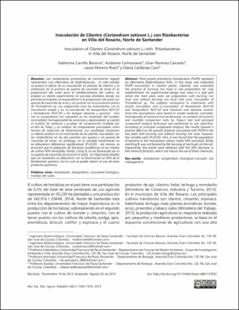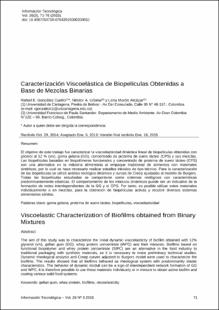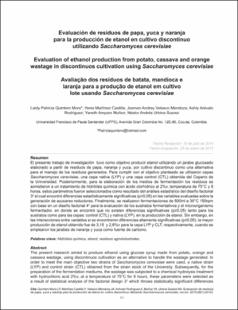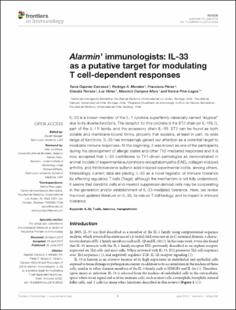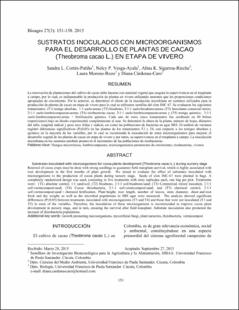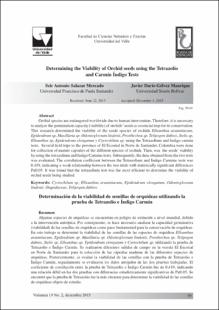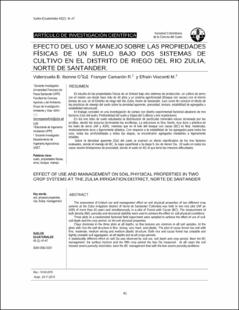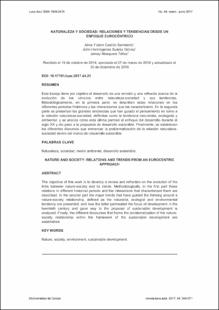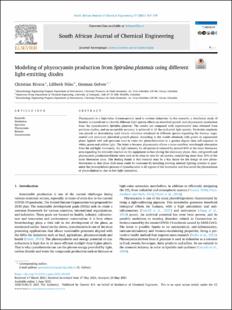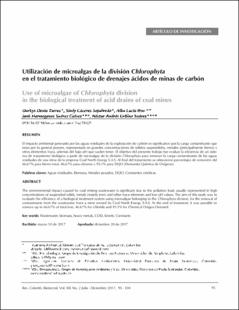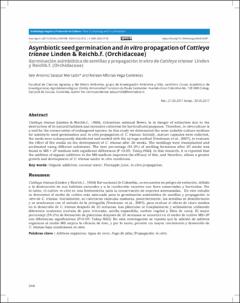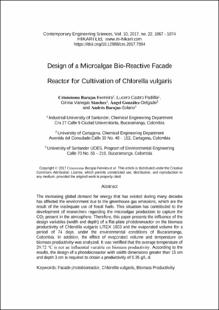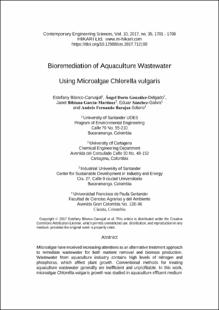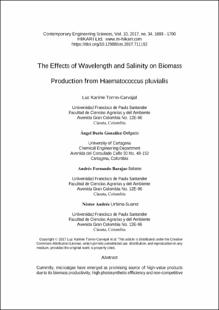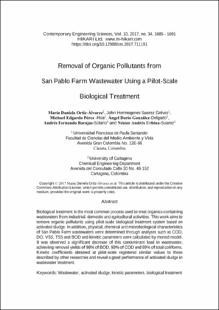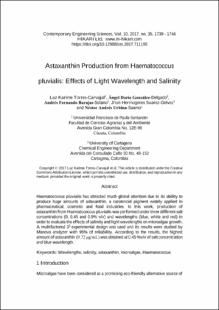Listar Ambiente y Vida - GIAV por fecha de publicación
Mostrando ítems 1-20 de 124
-
Inoculation of Cilantro (Coriandrum sativum L.) with Rhizobacterias in Villa del Rosario, Norte de Santander
(Revista Facultad Nacional de AgronomiaMedellín, Colombia, 2015-01-01)Plant growth promoting rhizobacteria (PGPR) represent an alternative biofertilization form. In this study, was evaluated PGPR inoculation in cilantro plants. Likewise, was evaluated the practice of burning rice husk in ... -
Caracterización Viscoelástica de Biopelículas Obtenidas a Base de Mezclas Binarias
(Informacion TecnologicaChile, 2015-01-18)El objetivo de este trabajo fue caracterizar la viscoelasticidad dinámica lineal de biopelículas obtenidas con glicerol al 12 % (v/v), goma gelana (GG), concentrado de proteína de suero lácteo (CPS) y sus mezclas. Las ... -
Evaluación de residuos de papa, yuca y naranja para la producción de etanol en cultivo discontinuo utilizando Saccharomyces cerevisiae
(Revista IONBucaramanga,Colombia, 2015-01-25)El presente trabajo de investigación tuvo como objetivo producir etanol utilizando un jarabe glucosado elaborado a partir de residuos de papa, naranja y yuca, por cultivo discontinuo como una alternativa para el manejo de ... -
Alarmin’ immunologists: IL-33 as a putative target for modulating T cell-dependent responses
(Frontiers in ImmunologyChile, 2015-06-02)IL-33 is a known member of the IL-1 cytokine superfamily classically named “atypical” due to its diverse functions. The receptor for this cytokine is the ST2 chain (or IL-1RL1), part of the IL-1R family, and the accessory ... -
Sustratos inoculados con microorganismos para el desarrollo de plantas de cacao (Theobroma cacao L.) en etapa de vivero
(BioagroBarquisimeto,Venezuela, 2015-09-27)La renovación de plantaciones del cultivo de cacao debe hacerse con material vegetal que asegure la supervivencia en el trasplante a campo, por lo cual, es indispensable la producción de plantas en vivero utilizando sustratos ... -
Determining the Viability of Orchid seeds using the Tetrazolio and Carmín Índigo Tests
(Revista De CienciasValle, Colombia, 2015-12-01)Orchid species are endangered worldwide due to human intervention. Therefore, it is necessary to analyze the germination capacity (viability) of orchids' seeds as essencial step for its conservation. This research determined ... -
Efecto del uso y manejo sobre las propiedades físicas de un suelo bajo dos sistemas de cultivo en el distrito de riego del rio zulia, norte de Santander
(Suelos EcuatorialesCauca,Colombia, 2015-12-10)El estudio de las propiedades físicas de un Entisol bajo dos sistemas de producción, un cultivo de arroz con el mismo uso desde hace más de 40 años y un sistema agroforestal (Bosque con cacao) con el mismo tiempo de uso, ... -
Identificación molecular de aislamientos de Moniliophthora roreri en huertos de cacao de Norte de Santander, Colombia
(Acta AgronomicaColombia, 2016-01-01)El hongo fitopatógeno Moniliophthora roreri produce la moniliasis, una enfermedad que destruye la mazorca de cacao (Theobroma cacao L.) y, por tanto, reduce la producción del cultivo y los ingresos de los agricultores. En ... -
Cultivo de cebolla (Allium cepa L.) en la provincia de Ocaña: factores asociados a la productividad y el rendimiento
(Revista Colombiana De Ciencias HortícolasColombia, 2017-02-10)El artículo tuvo como objetivo analizar factores asociados a la producción de la cebolla en la Provincia de Ocaña (Colombia) utilizando cuatro fórmulas de abono. La investigación siguió un enfoque cuantitativo, diseño ... -
Naturaleza y Sociedad: Relaciones y Tendencias desde un enfoque Eurocéntrico
(Revista Luna AzulManizales, Colombia, 2017-06)Este trabajo tiene por objetivo el desarrollo de una revisión y una reflexión acerca de la evolución de los vínculos entre naturaleza-sociedad y sus tendencias. Metodológicamente, en la primera parte, se describen estas ... -
Modeling of phycocyanin production from Spirulina platensis using different light-emitting diodes
(South African Journal of Chemical EngineeringPaíses Bajos, 2017-07)Phycocyanin is a high-value chromo-protein used in various industries. In this research, a simulation study of kinetics is carried out to identify different light spectra effects on microbial growth and phycocyanin ... -
Utilización de microalgas de la división Chlorophyta en el tratamiento biológico de drenajes ácidos de minas de carbón
(Revista Colombiana De BiotecnologíaColombia, 2017-07-01)El impacto ambiental generado por las aguas residuales de la explotación de carbón es significativo por la carga contaminante que estas por lo general poseen, representada en grandes concentraciones de sólidos suspendidos, ... -
Asymbiotic seed germination and in vitro propagation of Cattleya trianae Linden & Reichb.f. (Orchidaceae)
(Acta AgronómicaColombia, 2017-10-01)Cattleya trianae (Linden & Reichb.f., 1860), Colombian national flower, is in danger of extinction due to the destruction of its natural habitats and excessive collection for horticultural purposes. Therefore, in vitro ... -
Design of a microalgae bio-reactive facade reactor for cultivation of Chlorella vulgaris
(Contemporary Engineering SciencesBulgaria, 2017-11-14)The increasing global demand for energy that has existed during many decades has affected the environment due to the greenhouse gas emissions, which are the result of the inadequate use of fossil fuels. This situation ... -
Evaluation of In-Situ Transient Simultaneous Cell Disruption and Transesterification of Microalgae
(Contemporary Engineering SciencesBulgaria, 2017-12-07)Microalgae has recently been highlighted as source of valuable products including biofuel. The production process of biofuels from microalgae involves mass cultivation, harvesting, deep dewatering, lipid extraction and ... -
Bioremediation of Aquaculture Wastewater Using Microalgae Chlorella vulgaris
(Contemporary Engineering SciencesBulgaria, 2017-12-24)Microalgae have received increasing attentions as an alternative treatment approach to remediate wastewater for both nutrient removal and biomass production. Wastewater from aquaculture industry contains high levels of ... -
The Effects of Wavelength and Salinity on Biomass Production from Haematococcus pluvialis
(Contemporary Engineering SciencesBulgaria, 2017-12-24)Currently, microalgae have emerged as promising source of high-value products due to its biomass productivity, high photosynthetic efficiency and non-competitive environment for growth. In this work, biomass production ... -
Removal of Organic Pollutants from San Pablo Farm Wastewater Using a Pilot-Scale Biological Treatment
(Contemporary Engineering Sciences, 2017-12-24)Biological treatment is the most common process used to treat organics-containing wastewaters from industrial, domestic and agricultural activities. This work aims to remove organic pollutants using pilot-scale biological ... -
Astaxanthin production from Haematococcus pluvialis: effects of light wavelength and salinity
(Contemporary Engineering SciencesBulgaria, 2017-12-28)Haematococcus pluvialis has attracted much global attention due to its ability to produce huge amounts of astaxanthin, a carotenoid pigment widely applied in pharmaceutical, cosmetic and food industries. In this work, ... -
Gas-Liquid Hydrodynamics Simulation using CFD in a Helical Ribbon Impeller Applied for Non-Newtonian Fluids
(International Journal of Applied Engineering ResearchIndia, 2018)In the present study Computational Fluid Dynamics applied to non-newtonian fluids was developed in order to characterize the gas-liquid mass transfer in a 10 L bioreactor equipped with a helical ribbon impeller. Gas-liquid ...


